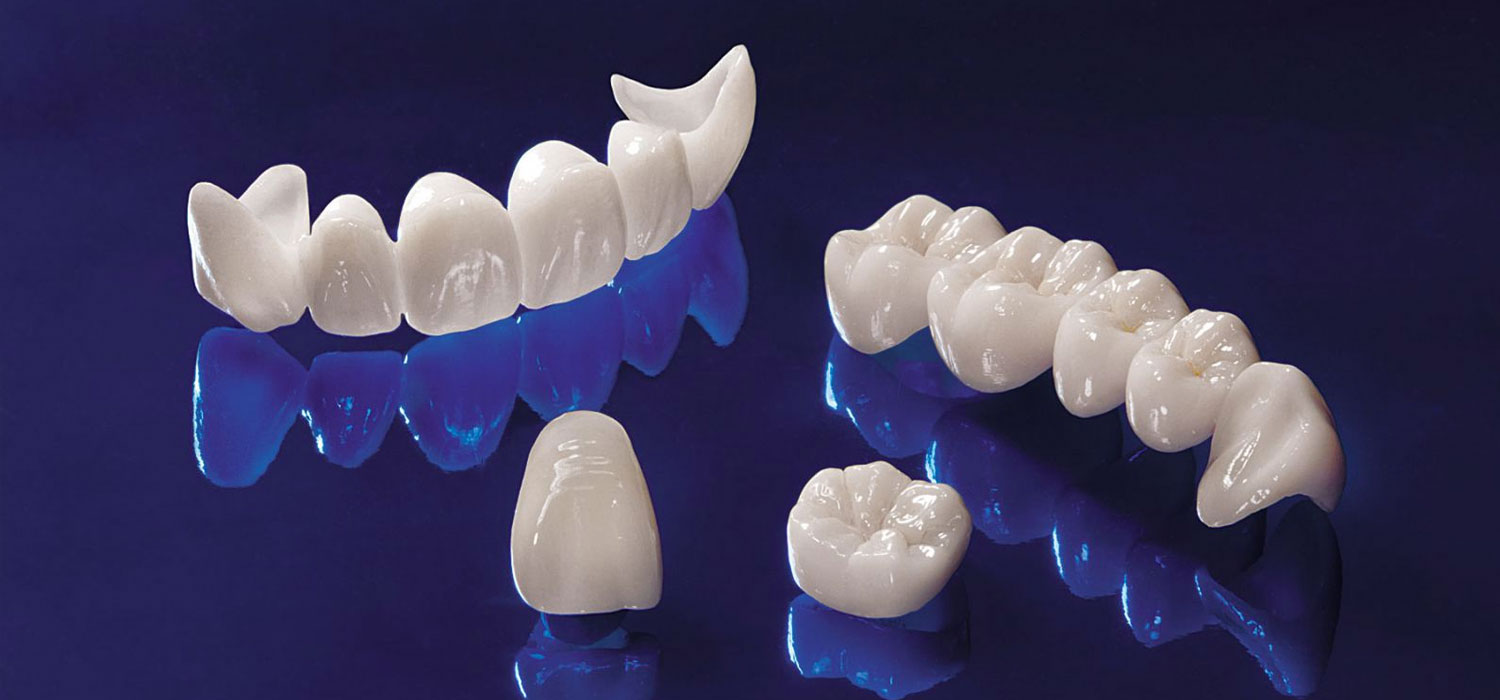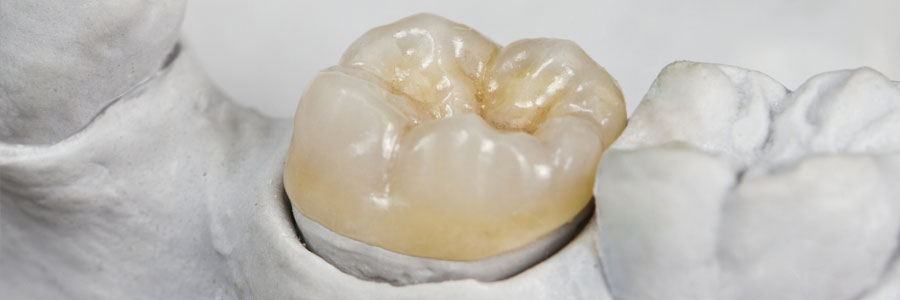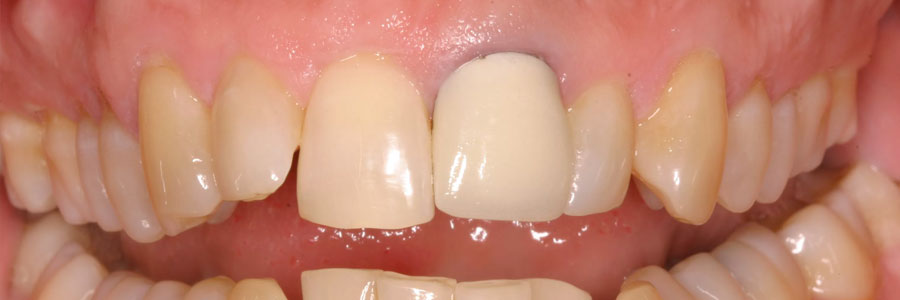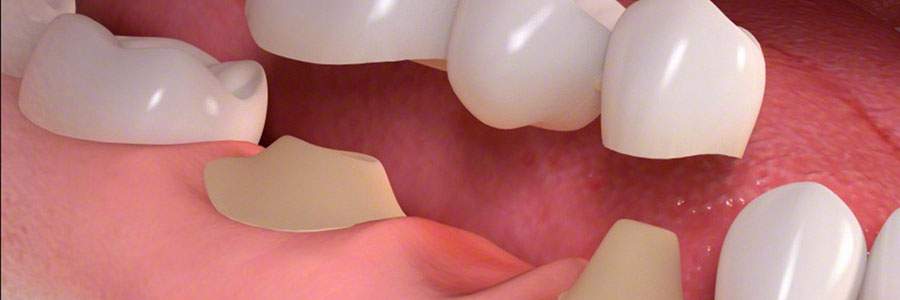
Crowns: A dental crown is a cap that encases the entire tooth surface, restoring it to its desired shape and size. Crowns are able to protect and strengthen the tooth structure, which cannot be restored by any other type of dental restoration. There are several types of crowns, but the porcelain coloured crowns are the most popular because they resemble natural teeth the best. Porcelain crowns are made to match the shape, size and colour of natural teeth. Crowns are highly durable and will last for many years. But like everything in life, if you don’t take care of them, you will eventually loose them
This procedure generally takes 2 appointments to complete. It is not uncommon for patients who undergo this procedure to experience tooth sensitivity, soreness in the gums, and a general discomfort with the teeth. After the placement of the permanent crown, all this should go away.
While you have your temporary crown in place, you should avoid chewing sticky or hard food. That’s because temporary crowns are only placeholders, and they are made of plastic or soft metal. Once you have a permanent crown in place, you may feel pressure for several days, and even your bite may feel different. If the feeling continues for longer than two or three days, call our dental office immediately.
The reasons why you would need a crown:
- Support a tooth that has been badly damaged by tooth decay
- Restore a tooth after a root canal
- Hold together a severely cracked or broken tooth
- Protect a worn tooth
- Anchor a dental bridge
The dental crown procedure has been performed by dentists for decades, and is considered to be a safe and very effective treatment. However, there are some important considerations that our Sunrise Village dental crowns patients should be aware of, including:
- Infection: If the affected tooth is not thoroughly cleaned out and sealed, an infection can develop.
- Allergic reaction: A small number of patients may experience an allergic reaction to the materials used during the dental crown treatment process.
- Tooth decay: If the crown is not properly sealed, bacteria can accumulate and damage the tooth.
- Poor bite: If the crown’s surface is not properly shaved down, it can result in an uncomfortable bite.
- Shifting of the crown: Over time, the crown can become loose or dislodged. Patients should expect to have their crown replaced after 10 to 15 years.
Bridges: Dental bridges literally bridges the gap created by one or more missing teeth. A bridge is made up of two or more crowns for the teeth on either side of the gap and a has false tooth/teeth in between. Bridges are cemented onto existing teeth by the dentist and can be easily removed if needed. If the patient doesn’t want a bridge, there are other options such as placing a dental implant in the space of the missing tooth.
How Long do Crowns and Bridges Last?
While crowns and bridges can last you a lifetime, they do sometimes come loose or fall out. The most important step you can take to ensure the life of your crown or bridge is to practice good oral hygiene. A bridge can lose its support if the teeth or bone holding it in place are damaged by diseases related to dental. Keep your gums and teeth healthy by brushing with fluoride toothpaste twice a day and flossing daily. Also visit our Hastings dental office for regular checkups and professional cleaning.
Frequently Asked Questions About Crowns and Bridges.
1. Will people be able to tell if I have a dental crown or bridge?
Today’s crowns and bridges are made of natural-looking composite materials that make them virtually indistinguishable from your natural teeth.
2. How Long Will They Last?
Both dental crowns and bridges will last a good long while, though how long depends on a few factors.
Good oral health requires you to brush and floss on a regular basis because oral hygiene should be your number one priority if you want the procedures to last and be effective in the long run.
You also need to avoid eating unhealthy foods that have a hard surface because it might damage the crown or bridge. Avoid sticky foods to prevent decay and your crown or bridge should last from five to fifteen years.
3. How are crowns placed on teeth?
 Crown placement is typically completed in two visits. First, we will remove a thin layer of enamel coating and shape the tooth to provide room for the crown. This process allows the crown to be placed without crowding neighboring teeth or creating an uneven bite. Then we make an impression of the teeth, which is sent to on-site lab where the crowns will be made from the most advanced materials for long-lasting durability.
Crown placement is typically completed in two visits. First, we will remove a thin layer of enamel coating and shape the tooth to provide room for the crown. This process allows the crown to be placed without crowding neighboring teeth or creating an uneven bite. Then we make an impression of the teeth, which is sent to on-site lab where the crowns will be made from the most advanced materials for long-lasting durability.
The dentist will fit a temporary crown, which is crafted of resin, to protect your tooth while the permanent crown is being made. At the second visit, the temporary crown will be removed and the tooth will be carefully cleaned before the permanent crown is applied using a strong adhesive.
4. Some people having Crowns with black, darkened lines in between their gums and teeth. Are they cause by Crown or Bridges?
 The newer all porcelain crowns are an esthetic improvement over older, porcelain fused to metal crowns as if the gumline would recede, the older crowns often showed a metal edge to the crown that originally was hidden from view. Since all porcelain crowns have no metal, no markings are evident if the gum line recedes.
The newer all porcelain crowns are an esthetic improvement over older, porcelain fused to metal crowns as if the gumline would recede, the older crowns often showed a metal edge to the crown that originally was hidden from view. Since all porcelain crowns have no metal, no markings are evident if the gum line recedes.
5. If having a root canal and it is quite discolored, can Porcelain Crown be the best approach?
If a tooth that requires root canal therapy discolors, it is an indication that the nerve inside the tooth had died and blood pigments have broken down and been absorbed into the calcified tooth structure. By placing an all ceramic porcelain crown on the tooth, it can restore the tooth to match its neighbors.
6. Should I replace my old crowns?
If your crowns are worn down or damaged, give us a call so that we can plan replacements. We may need to remove the crown and provide you with a new temporary crown until your new permanent crowns are complete.
If you’ve had your crowns for several years, you may be troubled by their aesthetics. Older materials used to create crowns were not as natural-looking and lifelike as today’s modern crowns. Metal crowns and porcelain-fused-to-metal may be a giveaway that you’ve had dental work done, and we completely understand that you want your smile to look its best.
We are happy to examine your teeth and provide a recommendation as to whether your crowns should be replaced. Give our Vancouver dental office a call to schedule your evaluation.
7. Which foods should avoid for not damaging your Bridges?
Patients fitted with dental bridges are advised by dentists to avoid chewing extensively on foods such as raw vegetables, hard candies, and ice. These foods can cause damage to the bridge, which may require replacement if it cannot be repaired.
8. How many type of Dental Bridges?
 There are three types of dental bridges:
There are three types of dental bridges:
- Traditional Fixed Bridge: A dental bridge is a false tooth, known as a pontic, which is fused between two porcelain crowns to fill in the area left by a missing tooth. This is known as a fixed bridge. This procedure is used to replace one or more missing teeth. Fixed bridges cannot be taken out of your mouth as you might do with removable partial dentures.
- Resin Bonded Bridges: The resin bonded bridge is primarily used for your front teeth. Less expensive, this bridge is best used when the abutment teeth are healthy and don’t have large fillings. The false tooth is fused to bands that are bonded to the abutment teeth with a resin which is hidden from view. This type of bridge reduces the amount of preparation on the adjacent teeth.
- Cantilever Bridges: In areas of your mouth that are under less stress, such as your front teeth, a cantilever bridge may be used. Cantilever bridges are used when there are teeth on only one side of the open space. This procedure involves anchoring the false tooth to one side over one or more natural and adjacent teeth.
9. Which foods should avoid with a temporary dental crown?
Because temporary crowns are made from acrylic, which is less strong than the metal, ceramic or porcelain material of a permanent crown, you must take extra precautions. Limit the amount of chewing you do on the side of your mouth where your temporary crown is located. Avoid chewing on hard candies, nuts and very crunchy fresh vegetables such as carrots on the same side of the mouth as your temporary crown. Until your permanent crown is in place, don’t eat sticky desserts or candy, including caramels, licorice, jelly beans, taffy, toffee and gummy bears, as they could pull the temporary crown off your tooth. Avoid chewing gum for the same reason.
10. Which foods should avoid for permanent dental crowns?
- Hot foods: Some individuals experience a mild-to-severe sensitivity in and around a crowned tooth when eating hot foods, particularly if they are affected by gum recession. If the problem persists, consult your dentist as the crown’s fit may require adjustment.
- Cold foods: Although they do not harm your crown, such foods can trigger sensitivity similar to that caused by hot foods if any part of your gum recedes enough to expose the root above a crowned tooth. Your dentist may suggest that you use a toothpaste made especially for sensitive teeth; such toothpaste work by blocking the sensation traveling from the tooth to the nerves.
Sugary foods: Avoid constant exposure to sugary drinks, candy or gum, keep snacking to a minimum, and brush or rinse your teeth after eating chewy or sticky foods such as dried fruit.
11. How do I care for my crowns and bridges?
It is important to maintain excellent oral hygiene, making sure to brush and floss twice a day. Avoid biting on hard foods like nuts and candy that can potentially fracture the restoration.

Do you guys do a payment plan for crowns or does it have to be paid in full. I do have insurance but it doesn’t cover the crown
Hi Nancy,
We currently don’t have any payment plans setup at the moment. But please call our office and I’m sure our office manager will help you find a solution.